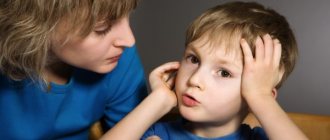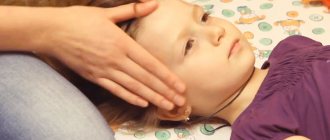Experts believe that by the age of 2, a child’s vocabulary should have at least 50 words. But what should parents do if their two-year-old child does not speak? Much depends on the efforts of adults, namely: the early development of speech in the baby and the meaningful orientation of the baby’s speech development, his ability to actively perceive words. Of course, each child is individual and begins to talk at the right time, but you can still help develop this skill with the help of special exercises and educational games.
How to get a child to talk: effective methods for developing speech in children 2-3 years old
The most common method of developing a baby's speech that parents use is a technique called “tell mommy.” Yes, indeed, this method is beneficial, but it is far from the only one. This technique is suitable for very young children who have just begun to pronounce their first sounds. But, if this method encourages the baby to simply imitate and unconsciously repeat after the parents, then the following techniques will help the child pronounce words meaningfully and understand what is being said.
Let's explore things together
If you want to develop your child’s speech skills, try to expressively describe everything he does. At the age of one year, children begin to actively explore the world around them. They touch objects, open and close doors, touch everything with handles.
Make it a rule to describe his actions. For example, when opening and closing doors, say: “Open the door, close it.” If the child picks up an object, describe it. For example, if a child took a spoon, you can say: “Look, you have a spoon in your hands. This is a spoon." Encourage any activity of the baby and focus on what he is doing.
Getting to know the pictures
There are a lot of educational books with colorful pictures that can help a child get to know the world. Buy your child books for the little ones, for example, from the section about animals called “Who Am I?” When showing a drawing of a cat in a book or on a card, you can say: “What does a cat do? “Meow.” Through these activities, you can introduce your baby to animals and help him pronounce certain sounds. This method is ideal for a baby, since he already understands that each animal has a particular sound. Try to study animals that you can see on the street. When a child sees a dog or cat, he will begin to say “woof” or “meow.”
Education through sound
Whatever your child does, try to indicate his actions with a certain sound. For example, if he claps, say “clap-clap,” even if he fell, don’t immediately run to pick up the baby and ooh and ahh at the same time, but rather say “boom, boom.” This approach even amuses children and they quickly forget that they just flopped. This method will help the baby realize that every movement has a certain sound, and his memory will actively develop.
Speech accompaniment
When your baby makes any sounds, ask him to repeat them. For example, tell your child, “How do geese make it? “Ga-ha-ha.” If he says something that you think is absurd, like “agu, booboo,” repeat after him. The child should be encouraged to speak, pronounce any sound and be encouraged to do so.
Child development at 2 years old
Age from one and a half to 3 years is an active and favorable period for mastering speech
Psychological processes are formed: memory, attention, thinking in conjunction with the process of speaking. By increasing the vocabulary of words, it is easier for a child to communicate with adults and learn about the world around them.
A two-year-old baby enjoys watching cartoons, listening to fairy tales, and is able to comprehend their content. Attention becomes more stable, memory and perception improve. The child is able to list objects around, establish simple connections between them, and make comparisons.
Parents should actively help their two-year-old child master speech and engage in play activities. The second year is characterized by active play, when the baby is easily interested in bright pictures, objects, and involved in joint activities. A baby in the 3rd year of life is able to make critical remarks about adults and himself, listen carefully, repeat words after his parents, and put them into sentences. From 2.5 to 3 years, the baby’s vocabulary increases 3 times, which stimulates improvement in the quality of speech. The child combines objects (dolls, balls, cars - toys; carrots, porridge, mashed potatoes - food).
Despite the expansion of vocabulary, parents should understand that clarity of pronunciation is not achieved immediately, which is due to age characteristics. The child pronounces simple words well: “mom”, “porridge”, “dad”, “grandfather”, “give”, “leg”. More complex constructions are not easy, but the baby tries to pronounce them in his own way: “hello”, “okay”, “please”, “no”, “banana”, “cat”, “dog”. At 2 years old, it is difficult for a child to pronounce individual sounds: f, s, ts, sh, zh, h, sch, r, l, th.
Situational business communication between mother and child is important in this age period. Playing together, washing hands, cleaning, eating, walking help master speech if parents pronounce each stage and the objects with which the action is performed
The baby actively copies and imitates an adult in everyday life, which allows the baby to form the following concepts:
- Spaces.
- Volume.
- Colors.
- Time.
- Emotions.
A two-year-old child, according to psychologists, neurologists and speech therapists, should:
- Have a vocabulary of 100-300 words.
- It is correct to point to a picture with an object, animal, or natural phenomenon.
- Construct simple sentences of 2-3 words.
- Name parts of objects, determine categories of surrounding things.
- Actively use the pronouns “we”, “I”, “you”, “he” in speech.
- Use prepositions in sentences.
- Ask questions.
- Express yourself with intonation and show emotions when speaking.
Speech development classes for children 2-3 years old: exercises for the development of phonemic hearing
Phonemic hearing is a subtle, systematized hearing that allows you to distinguish and recognize phonemes of your native language. This is an innate ability that allows you to distinguish between words consisting of the same phonemes. For example, “boar-can, nose-sleep”, etc. There are a lot of interesting and entertaining games that will help develop phonemic awareness in a child. Let's consider several such exercises for speech development.
Exercises and games for the development of phonemic hearing in children 2-3 years old
Find out by voice
The essence of this game is as follows: place the child with his back to the players. It is advisable that as many people as possible participate, but at least 3 people. The presenter asks one of the family members to say the name of the child, and he, in turn, must guess who called him.
Play with sounds
If you have various instruments at home, for example, a piano, tambourine, accordion or others, ask your little one to guess which instrument you play. Accordingly, the baby should not see what object you chose; you need him to determine by ear which instrument sounded.
Who's speaking?
Invite your child to pronounce the sounds characteristic of different animals. Be sure to prepare pictures of animals with their babies. For example, ask to show how a mother cat “speaks” - loudly and loudly, and how a kitten speaks - quietly and subtly. Then a dog and a puppy, a cow and a calf, etc.
Repeat after me
This game is played according to the following principle: mom or dad taps out some basic rhythm, and the baby must repeat. Then the sounds become more complex. When the child masters the game, invite him to create sounds, and you will repeat. Both fun and useful.
These games will not immediately give a positive result. During games, the child will develop memory and thinking, which will serve as an excellent basis for the development of phonemic hearing.
Exercises for general speech development at home
At home, it is imperative to regularly conduct speech therapy classes for children 4-5 years old, the exercises of which include not only the speech part, but also gymnastics for the speech organs and fingers.
Finger gymnastics
This set of simple exercises stimulates the part in the brain center that is responsible for correct speech. This is why fine motor skills classes are needed not only for the little ones, but also for preschoolers.
Finger exercises stimulate the part of the brain responsible for correct speech
All exercises are done 8-10 repetitions:
- “Opening” and “closing” the fingers on each hand. First one by one, then together. You can gradually increase the speed.
- Place your hands on the table: the left one touches the table with the palm, the right one with the back. Then at the same time you need to turn your hands over.
- First, draw a river: fold your hands, palms up, as if you have water in them. Then depict a steamboat - put your palms together, press your thumbs together and lift them up. Then depict the fish that have arrived: press all your fingers together, palms together and make movements with your hands, as if a fish is swimming.
- Draw a tree with branches - arms vertically, fingers spread out in different directions. Then show the roots of the tree - in the same position, move your hands with your fingers down. Then show leaf fall: quickly, quickly clench and unclench your fingers.
Articulation gymnastics
These exercises are aimed at developing the tongue, the main organ responsible for the correct pronunciation of sounds.
Note! Thanks to regular training in articulation gymnastics, the child will soon begin to pronounce even the most difficult sounds for him.
Smile as wide as possible, teeth are closed, exactly on top of each other. Stay in this position and count 10 seconds. Pull your lips forward and pretend as if an elephant is drawing water with its trunk. Stay for 10 seconds in this position. Pretend to be a snake: smile broadly, stick out your tongue like a tube, then hide it back. Open your mouth wide and click your tongue, imitating a horse.
At the same time, it is important to ensure that the child’s lower jaw is motionless and only the tongue is working. Smile widely, stick out your tongue as far as possible and lightly squeeze it between your teeth. In this position, “pull” the tongue back into the mouth. Open your mouth wide, stick out your tongue and pretend to be a clock - move your tongue from one corner of your mouth to the other.
Repeat all these exercises 8-10 times or for 10-15 seconds.
Games for developing phonemic sound
Speech therapy games for 4-5 year old children to develop phonemic sound must be included in daily classes. They are simple and at the same time interesting, and the results will not take long to arrive. After just a month of regular exercises, the quality of children's speech will noticeably improve.
- "Game of Silence" This game is very simple. The child is asked not to make a sound for 2 minutes and close his eyes. As soon as the time is up, then ask the baby to tell what sounds he heard.
- "Clap-stomp." The essence of the game: agree in advance with the child which sound he will stomp on and which sound he will clap on. For example, if he hears a sound, then he stomps his foot, if there is a sound, then he claps his hands. Next, the adult names different sounds, and when the child hears the ones he needs, he claps or stomps.
- "Catch the word." The essence of this game is simple: the child is given a word, upon hearing which he will have to clap his hands. Next, the adult names several words in turn that sound similar. As soon as the child hears what he needs, he should clap his hands.
To develop phonemic sound, it is necessary to regularly play speech therapy games
Finger games for speech development in children 2-3 years old
Finger games are an excellent and easy method for developing fine motor skills, which contribute to the development of speech in children. Dedicate 10-15 minutes a day to finger games, but no more. Also, do not try to learn all the games at once, 2-3 games will be enough to start with, after which you can change the games for new ones.
How can finger games help a child speak? Very simple. The essence of the games is that the parent recites poems during classes, where the same words are often repeated. Thus, the child perceives the mother’s words by ear and understands what is being said. And then he tries to repeat the sounds himself.
You can start working with your child with the most basic finger games such as “magpie-white-sided” or “horned goat is coming.” Offer your child another game: take the baby’s hand, and, bending his fingers, pronounce the names of relatives. For example, this finger is dad, this finger is mom, etc.
Game "fingers up"
This finger wants to sleep, This finger jumps into bed, This finger takes a nap, This finger is already asleep. Fingers stood up - “Hurray!” It's time to go to kindergarten!
Bend the baby's fingers, and then use your thumb to “wake up” everyone else. With an exclamation of “Hurray!” Unclench your fist completely, as if all your fingers are awake.
Children learn about the world through touch. You can arrange a whole finger theater, knit or sew interesting animals for a more interesting and colorful game.
Recommendations for parents
Games for speech development can be played with a child not only in a preschool educational institution, but also at home in his free time
It is important that parents monitor the correctness of their own speech, since the child absorbs everything like a sponge. For him, family members are the standard, and if one of the people close to him has pronunciation defects (burr, lisp, softens hard sounds in words) or constructs sentences incorrectly, then the baby will begin to imitate this too
At home, in addition to gardening activities, you can read books, tongue twisters, tongue twisters, learn short poems, have conversations, and you should not stop working even in the summer.
If a child attends a speech group at a correctional kindergarten, then it will be useful to perform speech therapy exercises for children 2-3 years old; this will allow them to refine the material poorly learned in classes with a speech therapist and consolidate it.
Note! Our speech therapy portal and its readers highly appreciated the quality of speech therapy services. ★★★★★ This is the only center in Moscow and Central Russia where professionals work, whose main principle is to correct any speech defects in the shortest possible time, including remotely online
Go to website >>>
Articulatory gymnastics for speech development in young children
By developing your baby’s speech from an early age, you will help your baby quickly express his thoughts and desires through words. The main goal of articulatory gymnastics is to enable the child to develop a certain skill for competent pronunciation of sounds. By training the speech apparatus, you help your child learn words correctly.
Recommendations for conducting speech gymnastics:
- Do the exercises regularly, because any skill needs to be consolidated gradually.
- Do not offer your baby more than 2-3 exercises at once.
- Each lesson should last 5-10 minutes.
- Be sure to practice the completed exercises several times.
- Carry out gymnastics in a playful way, as the baby will not be interested in performing static, monotonous movements.
At the age of 2, children do not have a pronounced speech problem, but for the sake of prevention, simple entertaining exercises should be performed.
Articulation gymnastics:
- “Opening and closing the gates . Invite your baby to open his mouth and hold this position for a few seconds.
- “Show me the fence.” When you invite your baby to show you the “fence,” he should clench his teeth and smile broadly.
- “Brushing and brushing our teeth . Together with your baby, open your mouth wide and run your tongue along the inside and outside of the teeth.
- "Artist". This exercise is more difficult. Invite the baby to use his tongue to draw any elements on the sky. And then, like a painter, you can completely paint over the entire sky.
Be sure to do your classes together. These exercises develop the mobility of the organs of the speech apparatus. Articulation gymnastics is the key to beautiful and correct sound pronunciation in children at an early age.
Articulation gymnastics
Speech therapy classes for 5-6 year old children must include articulation gymnastics, which is a complex exercise for warming up the tongue and lips. The baby’s ability to perform some of the movements necessary for correct sound pronunciation depends on how trained and developed the tongue and lips are. To make activities with your child effective, be sure to use a mirror of the appropriate size. The baby must see how his speech organs work. You don’t need to be a speech therapist to show your child how to do the exercises correctly:
"Swing". Smile, showing all your teeth. First, lower the tip of your tongue to your lower teeth, then lift it and hide it behind your upper teeth. The result is a kind of swing. Ask your child to repeat the exercise after you 4-5 times while playing. “Brushing our teeth.” By the age of 5, children can already keep their mouth clean on their own. In this exercise, you need to imitate brushing your teeth and rinsing them, but without using toothpaste and a brush. Starting position: smile with your mouth wide open. Next, you need to tense the tip of your tongue and clean the lower teeth from the inside with all your might, then lift the tip up and carefully work on the upper teeth
It is important that you cannot close your mouth. Repeat the exercise 8-10 times
Now ask your child to close his mouth and “rinse” it. "Jam". You need to smile with your mouth slightly open. Now ask your baby to lick first the upper and then the lower lip with the tip of his tongue. After 10 repetitions, you need to change the direction of movement.
Regular repetitions of these simple speech therapy exercises will actively contribute to the development of speech in a 5-6 year old child.
Onomatopoeia and logorhythmics
Classes with a speech therapist in the clinic often include a block of exercises to develop correct hearing. At home, you can easily create similar conditions to develop your child’s speech and auditory perception with the help of simple exercises. All you need is time, a phone or computer with a speaker, and available tools.
Games aimed at developing hearing:
- "Ears". Take several items made from different materials. Metal and wooden spoons, glass and crystal glasses are suitable. Invite your child to listen to what these objects sound like, then ask him to close his eyes and guess what this thing is just by ear.
- "Meow". Find a recording online with the voices of animals known to your child. Turn it on and ask your child to guess which animal the voice belongs to.
- "Street". Download a recording with the sounds of various vehicles. Invite your child to listen to it and say what kind of transport passed. For recognition, it is better to take familiar types of vehicles - a truck, car, motorcycle, tractor.
- “Where is the noise?” An excellent game for developing spatial hearing. Place the child in the center of the room and blindfold him. Take the bell and walk around it silently, jingling it periodically. The baby needs to identify the source of the noise by ear and point his hand in its direction.
To develop hearing and speech, speech therapists often ask children to imitate the voices of animals and birds, as well as household noises. Take turns saying “tick-tock”, “chick-chick”, “drip-drip”, “woof-woof”, “w-w-w” and the like with your child.
Logorhythmics is a set of exercises that includes the simultaneous use of movement, speech and music (optional). With the help of such games, developing a child’s speech is as easy as shelling pears. Remember about the bull that walks and staggers. Speak the text, show the movements. Let the child repeat after the adults. It will be fun for both the child and you.
Expansion of vocabulary and speech development
For a child, games for speech development, first of all, should be interesting. Tongue twisters are what you need for useful and productive communication in a playful way. Short rhyming phrases are easy to remember, which allows you to seriously expand your baby's vocabulary. A 5-year-old child uses passive and active dictionaries. The first consists of words that he understands, the second - those that he often uses. To improve both vocabularies, be sure to include tongue twister exercises in your speech development games.
Advice from experts on speech development in children under 3 years of age
Parents often begin to panic when their child does not want to start talking. Regarding difficulty speaking, authoritative pediatrician E. O. Komarovsky says the following:
“Speech difficulties may be caused by the fact that adults do not actively communicate with the child. But when the baby goes to kindergarten, he will make up for lost time, as children quickly try to adapt in society, purely instinctively. But there is a high probability that he will have problems with pronunciation, so it is better to work with the child from an early age.”
R. Levykin, psychologist:
Useful for speech development:
- Talk to your child as much as possible and encourage him to speak as much as possible. Ask him questions. Ask for his opinion. Comment on your actions.
- Develop your horizons. Walk more: gardens, playgrounds, parks, museums, zoos, walks in the forest, etc.
- Develop hand motor skills: plasticine, paints, crafts made from natural materials, construction sets.
From the book by I. A. Ermakova “Talk to me, mom! Educational activities for kids" :
Speech therapy massage of the facial muscles helps correct speech development. A light massage of the cheeks, forehead, and lips helps regulate blood circulation, improves muscle elasticity and serves as an effective way to prevent speech disorders. Light circular movements should be performed with the fingertips of both hands so that folds do not form on the skin. The massage should be done slowly and smoothly for 2-5 minutes 2 times a day. The duration of the course is 10-15 sessions. Before starting the massage, you need to cut your long nails, thoroughly wash and warm your hands, and lubricate your fingertips with nourishing or baby cream.
- Perform light circular movements from the middle of the forehead to the temples.
- Perform light circular movements from the middle of the forehead to the earlobes.
- Perform light circular strokes under the eyes from the nose to the temple area.
- Perform light circular movements from the middle of the forehead to the neck.
- Perform light circular movements from the wings of the nose to the corners of the lips.
- Perform light circular movements from the wings of the nose to the earlobes.
- Perform light circular movements along the contour of first the upper and then the lower lip - from the corners to the middle.
- Lightly tap your lips with your fingertips.
- Perform light circular movements from the middle of the upper lip to the chin.
Yu.S. Kosmina, speech therapist of the highest category:
In the family, conditions must be created for the child so that he experiences satisfaction from communicating with adults, receives from them not only new knowledge, but also enriches his vocabulary, learns to construct sentences correctly, pronounce sounds clearly, and tell interesting stories.
By expanding the child’s range of ideas about surrounding objects and phenomena, talking with him on various everyday topics that are close and understandable to the child, parents will thereby not only expand his horizons, but also contribute to the mastery of correct speech.
Speech pathologist-defectologist Anna Makovey about methods of speech development in twins:
Twins are a special topic. They have each other and that says it all. A special language, complete mutual understanding and no incentive to master the generally accepted language. It seems to me that the most humane of all the tested means (here is separation/distribution to grandmothers and division of responsibilities for raising each person between father and mother) is the introduction of children into a group of peers. There, children realize the need to master speech and learn to voice their needs (which is vital in kindergarten).
Individual communication with parents also helps to “talk” such children. It's up to your imagination and resourcefulness. One goes with dad to the store for... (something very necessary!!! You can’t handle it alone!), the second stays with mom... boil the kettle, wash the dishes, etc.
Don’t worry if your child doesn’t start talking at 1.5-2.5 years old. You should be afraid if a child at 3 years of age does not want to utter a single sound. This is a reason to contact a specialist who will help you find the answer to the question of why the child cannot speak.
Teach your children, develop their speech, thinking, memory, because a lot depends on the parents. And with such a set of modern techniques, books, educational games, you can decorate not only your baby’s everyday life, but also your own.
How to formulate speech correctly
Respond to the baby's humming and babbling, imitate his sounds, repeat them. Talk to your baby when you are caring for him: swaddling him, feeding him, bathing him.
Talk to him throughout the day. Read bright, colorful books every day. Repeat short rhythmic poems and nursery rhymes. Teach your child the names of loved ones and the names of all the objects around him. Take your baby with you to new places, be with him in different situations. Draw the child's attention to various objects that make sounds (animals, birds, vehicles, etc.). Encourage your child to try to pronounce new words. “Talk” with your child new situations in which he finds himself, before, during and after the event. Look at the baby when you talk to him. Describe in detail and colorfully to your child what he hears, sees, does and feels. Play children's songs and fairy tales for your baby. When talking with your little interlocutor, do not imitate children's pronunciation; make sure that your speech is clear, expressive (but without babying), competent, simple and clear. Praise your child every time he initiates communication with you. Make sure your child does not use sound pronunciations to indicate surrounding objects.
Parents can use simplified forms of the words “give”, “am-am”, “tu-tu” when communicating with a child under one year old. This will help him get involved in the process of speech development. Then it is advisable to accompany the simplified words with the correct names. He saw the train: “Tut-tut!” - Mom responded: “Yes, the train has left.” The child is asked: “Who is this?” - he answers: “Woof-woof,” - mom explains that “woof” is said by the animal “dog.” Be sure to correct mistakes in your child’s speech, do it tactfully, otherwise the child may lose confidence in you. Enrich the child’s simplified speech: “More juice,” “Tanya wants more orange juice.” Choose not a narrative, but a descriptive style of communication (“There’s a crow flying” - “Look, there’s a crow flying over that house. It’s black and can croak loudly”). Listen to your child's answers to your questions, encourage his attempts to speak out. Help your child learn to listen and follow instructions through simple requests, naming a sequence of actions (preferably in a playful way): “Go to your room and bring the teddy bear.” For the development of a child’s speech abilities, play activities are very important, through which the child learns about the reality around him. So play with your baby! Include your child not only in the game, but also in real interaction with all family members. Be sure to give your little one useful tasks. Pass requests to other adults through it. Thank you for your help. Read every day; perhaps reading should be part of your evening bedtime ritual. Always listen carefully when your child speaks to you. Explain to your child what you think, what you plan, what you do, how you reason. Ask your child questions, stimulate him to think, encourage him to answer. Discuss with your child how he spent the day in kindergarten, how your walk together went. After playing with your child, remember the most interesting moments. Use visual materials. It is difficult for children to perceive words separated from an image. Show your child that you are listening to him carefully: nod, smile, answer his questions. And most importantly: support all your child’s endeavors, praise him even for minor successes.
How to determine the level of speech development of a baby?
Most modern parents are aware of the importance of developing a child's speech and jealously monitor how their baby speaks. This is manifested primarily by comparing the child’s speech development level with the way his peers speak.
It’s great if the baby speaks willingly and quite intelligibly. But if a child speaks very little, is so unintelligible that it is impossible to understand him, or is completely silent, this seriously worries his loved ones.
However, to determine the level of development of a child’s speech, it is not enough to compare his speech with the way his peers speak. To determine whether a child’s speech corresponds to age standards, tables of the dynamics of speech development are used. This kind of information is in the public domain and gives a general idea of the stages of speech formation in a child - in what periods humming, babbling, first words and phrases appear, how his passive gradually develops (what the child understands, but does not yet speak himself) and active vocabulary (what the child understands and uses in his own speech). By carefully testing your child's speech, you can identify gaps in its development.
General rules for teaching children
A favorable atmosphere in the family, emotional contact with parents is an important factor in the speech development of children 2-3 years old.
What a particular child’s speech will be like at 2.5 years old is also influenced by your attitude. Everything should take place in a calm and harmonious atmosphere, which is primarily filled with love. Already in the first days of life, during the practice of the first emotional communication between mother and child, the foundation is laid for the further development of the baby.
When thinking about how to teach a child correctly, first of all focus not on general norms, but on him as an individual. Most likely, the child’s communication with others will be the same as your communication with him. Sometimes you will be surprised by your child’s “adult” habits, but you should understand that it was you, consciously or unconsciously, who contributed to their formation.
It is necessary to select and apply exercises for the development of speech in children not only when problems have already been identified - this needs to be done in advance. Moreover, playful activities will make your child’s leisure time more fulfilling and exciting. Professionals develop special speech games taking into account the interests and capabilities of the child, which always leads to better results.
The late development of children's speech should not worry you if this phenomenon is typical for their character type.
It may be normal for your child to say his first word only after one year, and to begin communicating in full sentences from the age of three.
How to teach a child to speak
To teach a child to speak at 2 years old, try to pay more attention to the baby: communicate with him, play, do simple exercises.
To become a real pro and help your child, you don’t have to have many years of experience interacting with kids. Just use games to develop speech in a 2-year-old child. Communicate regularly with your baby and be very attentive to him
It is worth paying attention to what good pediatricians advise, for example, Komarovsky
If we teach a child, but don’t know the rules on how to develop a child’s speech, don’t worry
Even if you pay attention to expert advice later, you can improve the development of children, at any age. But the sooner you start working with your child, the better the results will be.
Toys for speech development will be fun helpers for you and your baby:
- toys with slots like piggy banks;
- mosaics
- toys with rods on which you put things on
- pyramids
- lacing
If you want to use any medications for your children, be sure to consult your doctor. Even vitamins and minerals are prohibited from being taken uncontrolled.
Classes on speech development for children 3-4 years old can be conducted by professional speech therapists, but only if the children have the appropriate emotional mood. Only a positive mood contributes to good learning and positive learning outcomes.
Speech therapy tasks
Starting with the letter R
One of the most difficult sounds to master is R. Many preschoolers learn to roar loudly by the very end of kindergarten. If the production of the sound P is already behind you, then special exercises will help speed up its automation:
1. “Like a little motor”
We ask the child to pronounce the sound R in the word for a long time, drawlingly (like a motor growls).
2. “Where is R hiding?” (in pictures and words)
Offer to choose pictures with images of objects with a given sound or clap your hands if he hears such a word.
3. “How can you growl?”
Show your child pictures of objects that have the sound r in their names. Offer to read and color the picture.
4. “Sounding tracks”
Together with your child, come up with several chants made up of several syllables:
Ra-ra-ra - they ran away from the yard.
Ro-ro-ro - and they found a bucket.
Ru-ru-ru - we came up with a game.
5. “Substitute a syllable”
The adult offers the child words that end or begin with a syllable with P (ra, ro, ry), the child must choose the correct option and pronounce it correctly.
6. “Look and name”
An adult asks the child to read words with the letter r from the pictures. The word must be said as many times as there are stars next to each picture.
7. “Poems, tongue twisters, riddles”
Learn with your child several poems and riddles in which words with R appear.
Starting with the letter L
The hard sound L is also often difficult for children 5-6 years old. If the baby has already learned to pronounce it alone, in isolation, then it’s time to start working on automation in speech. The following exercises are suitable for this:
1. “Say it nicely”
Offer your child several images of words starting with L. Ask him to pronounce the words beautifully, emphasizing the desired sound with his voice.
2. “Toys for Larisa”
Ask your child to collect gifts for the Larisa doll. Tell her that she only likes things that begin with L. For this exercise, you need to select small objects or pictures in advance; all words should not begin only with L.
3. “One-many”
Invite your child to name words with L in the singular and plural. In the workbook for the sound L (author Kostyuk A.V.) there is a whole table with pictures for this exercise (lesson 20).
4. “Find the Sound”
Invite your child to draw up a diagram of the word and mark the place L on it. If it is still difficult for your child to independently determine the number of sounds, then first you can do several similar exercises from the workbook.
5. “Tongue twisters and nursery rhymes”
Use nursery rhymes, tongue twisters and poems with words that contain L.
Starting with the letter Sh
Difficulties with hissing in children 5-6 years old are also quite common. The following games are suitable for automation:
1. “Who’s hissing?”
Invite your child to choose several pictures of those who can hiss. Ask them to say their “song” clearly, loudly, and for a long time.
2. “Catch the Sound”
Ask your child to clap their hands every time you say Sh or a word with that sound (among others).
3. “Syllables Travel”
Take a card with one of the syllables SHA, SHO, SHU. Offer to come up with words or several that begin with this syllable and end with it (Sha-ry and ka-Sha, sho-rokh and ho-ro-sho).
4. “What are the guys’ names?”
Ask your child to read the children's names, adding the syllable SHA at the end.
4. “We compose speech therapy rhymes”
Come up with short rhythmic chants with the syllables SHA, SHO, SHU, SHI.
Sha-sha-sha - the porridge ran away,
Sho-sho-sho - have a good rest,
Shu-shu-shu - dry mushrooms and berries.
5. “Speak beautifully and correctly”
Ask your child to pronounce words with the Sh sound correctly.
The use of workbooks not only allows you to properly organize speech development classes for children 5-6 years old, but also makes it possible to train graphic skills, attention, thinking, and imagination. To reinforce the material, also use video lessons:
To reinforce the material, also use video lessons:
Games and exercises for the development of impressive and expressive speech
Work on correcting SRD is built in stages, according to the principle “from simple to complex.” Thus, classes aimed at expressive speech begin with pronouncing sounds, then syllables, simple words, and only after the previous stages have been worked out do they move on to phrases and sentences.
It is very useful for mental retardation to combine such activities with physical exercise. This will help develop motor skills and learn the material faster.
For example: a game aimed at learning vowel sounds in RRD. Children usually play this game with pleasure. Vowel sounds must be sung, combined with smooth hand movements.
Technique for performing the lesson:
- “aaa” - arms spread wide apart;
- “uuu” - smoothly bring your arms straight in front of you;
- “oooh” - wide to the sides and up, bring your hands together above your head;
- “iii” - to the sides, down;
- “yyy” - squat down, arms bent, pressed to the body;
- “uh” - movement of the arms to the sides, down.
The next step is to study the consonants “d”, “b”, “m”, “p”. After the vowels and these four consonant sounds are mastered, you can begin to study hissing sounds and sonorant “r”, “l”.
With mental retardation, work on vocabulary (active and passive) should always occur: while doing household chores, taking a walk, or performing daily hygiene procedures. At the same time, patience and calm are required from parents. You cannot rush the baby or use the phrases: “Say”, “Repeat”. Such pressure can negate all the work to overcome the SRR and further aggravate the situation.











